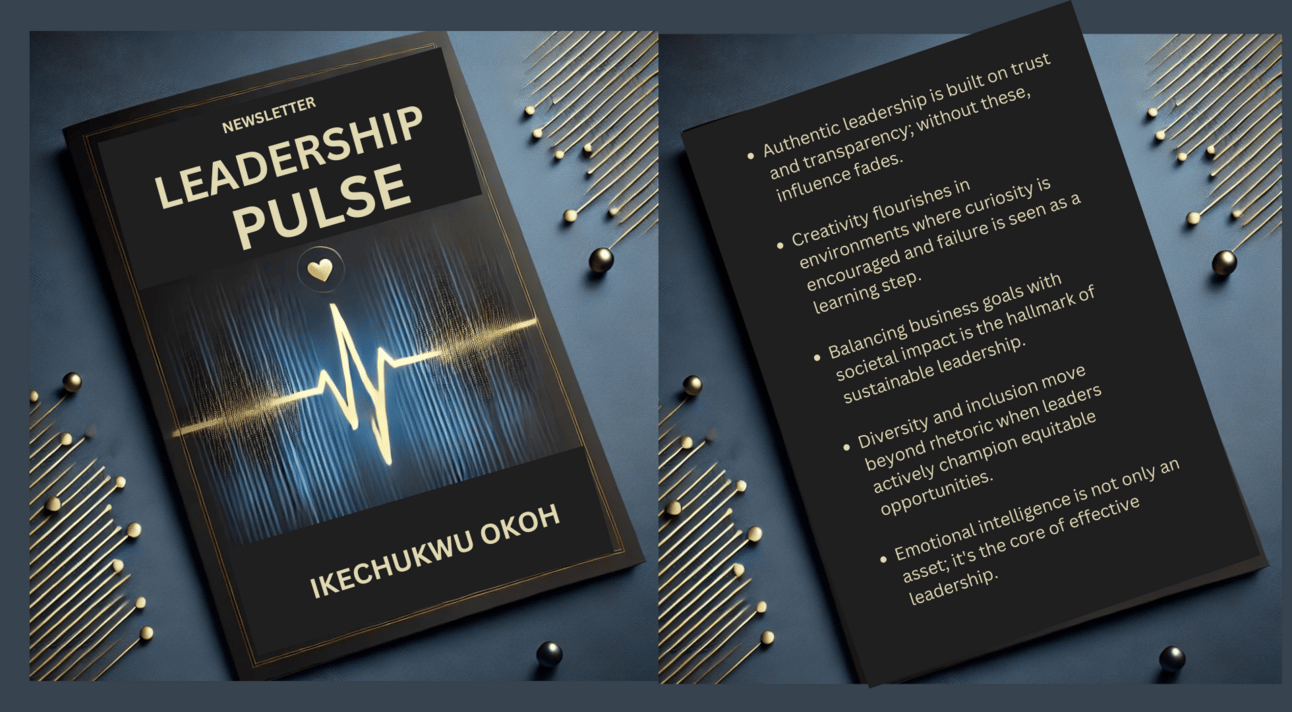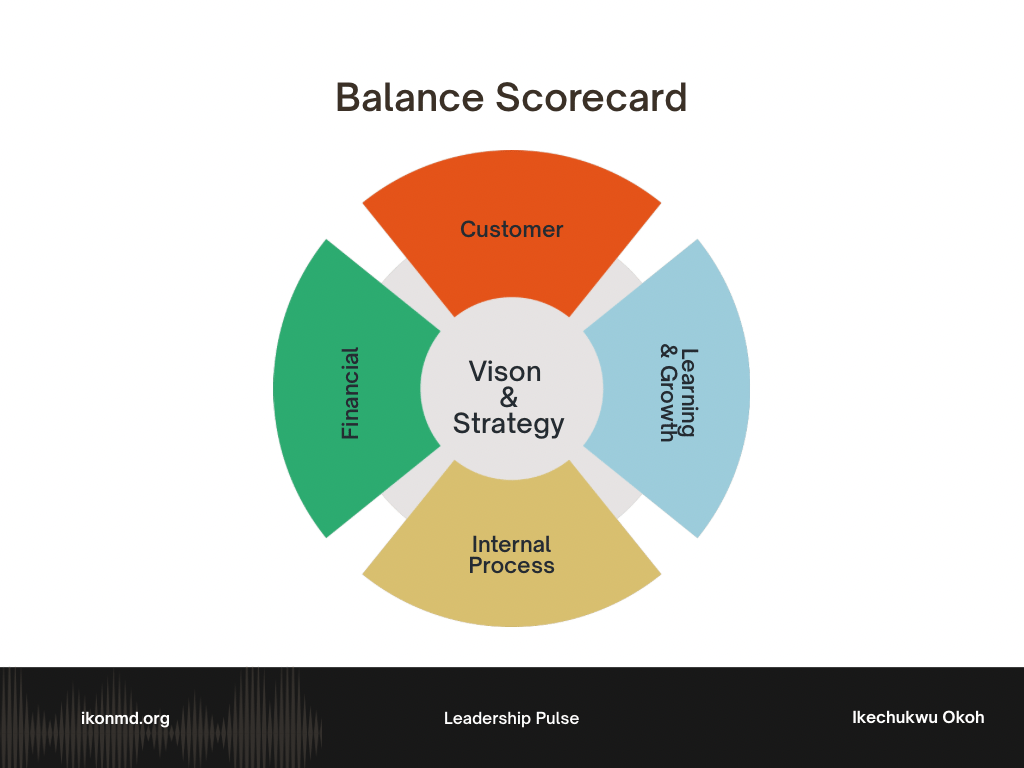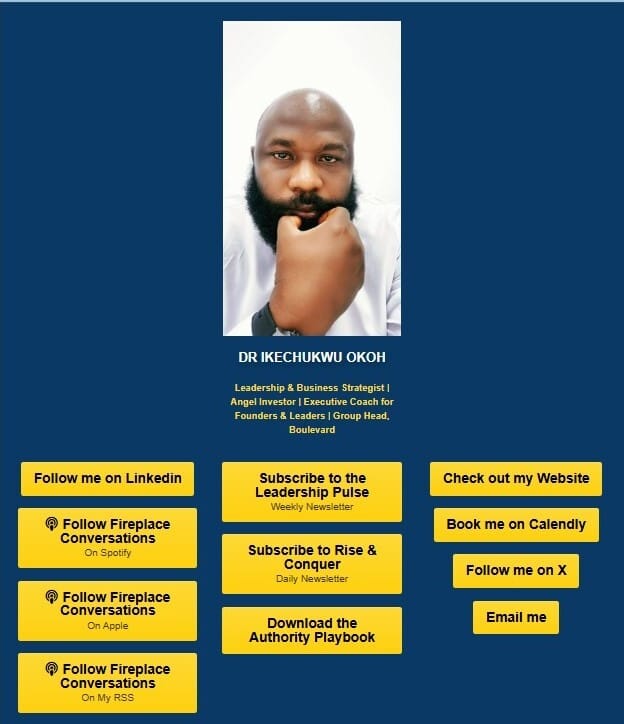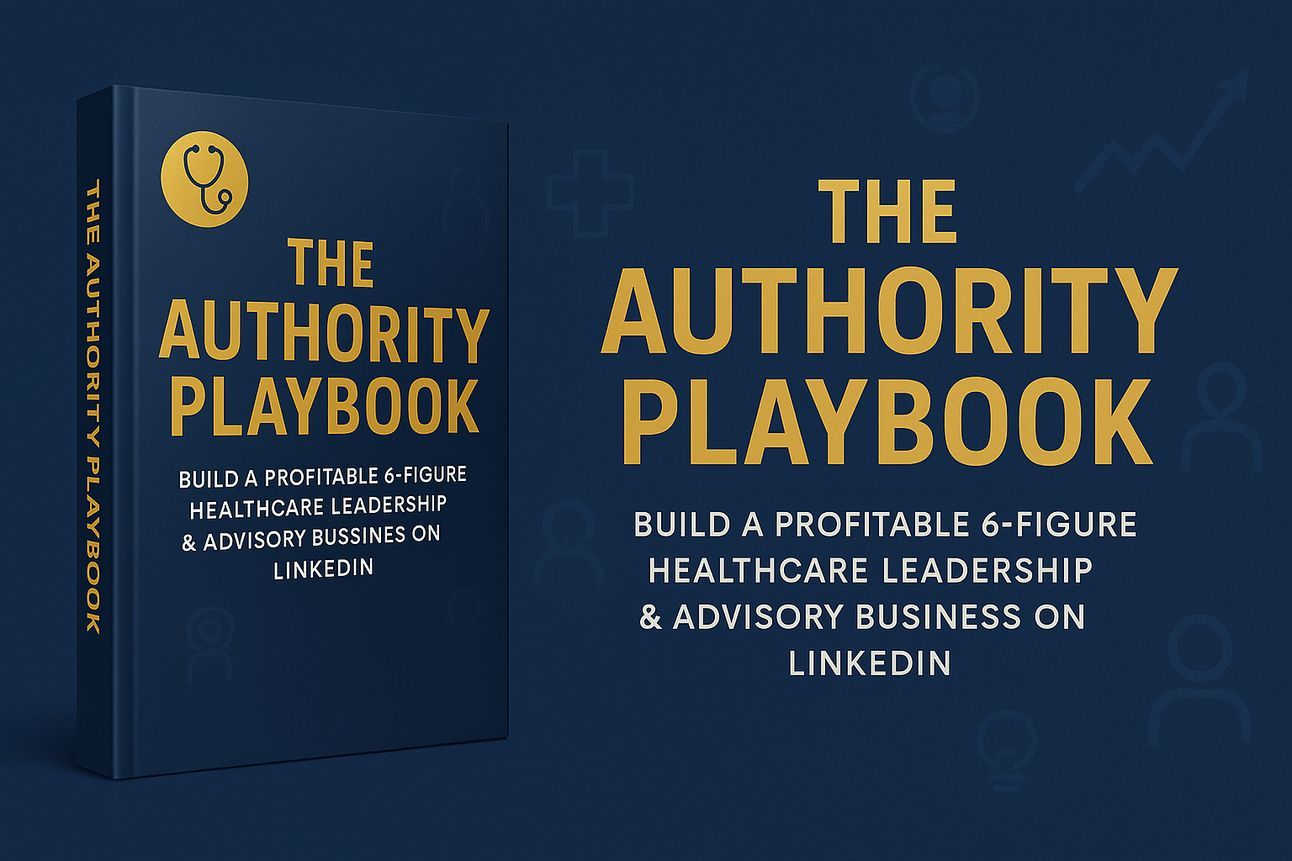- Leadership Pulse
- Posts
- The Balanced Scorecard
The Balanced Scorecard
Turning Vision Into Measurable Action

Last year, during one of our coaching sessions with a mid-sized healthcare organisation in Lagos, something remarkable happened. The CEO, an energetic woman named Clara, sat at the head of the conference table surrounded by her leadership team. They had come to us feeling frustrated. Despite their growth, profits remained flat. Employee turnover was high. And their ambitious mission statement, which was to become West Africa’s most trusted integrated health system, felt more like a slogan than a shared direction. | When I asked what their strategy was, Clara smiled. “We’re customer-focused,” she said. “We deliver quality care and expand access.” Her CFO added, “We’re trying to manage costs.” Their HR head chimed in, “We want to build a great culture.” Everyone was right. Yet everyone was speaking a different language. That was the moment I introduced them to one of the most transformative tools in modern management called the Balanced Scorecard. |
The Origin of the Balanced Scorecard
Developed in the early 1990s by Robert Kaplan and David Norton at Harvard Business School, the Balanced Scorecard arose from a simple question:
Why do so many well-formulated strategies fail during execution?

Traditional performance metrics like revenue, profit, and market share highlight how companies performed in the past, but do not explain why.
The Balanced Scorecard bridged that gap.
It provided leaders with a new perspective:
To assess performance not only financially but also through four interconnected lenses that contribute to long-term success.
Financial Perspective: How do we appear to our shareholders?
Customer Perspective: How are our customers perceiving us?
Internal Process Perspective: What internal areas must we excel at to deliver value?
Learning & Growth Perspective: How can we continue to improve and create value?
When an organisation aligns goals, measures, and initiatives across these four areas, strategy transitions from the boardroom into everyday actions.

The Coaching That Changed Everything
Back to Clara’s team.
I handed them a blank Balanced Scorecard template and said,
“Let’s turn your vision into a system of measurable actions.”
We started with their vision statement:
To be West Africa’s most trusted integrated healthcare system.
It sounded inspiring but also vague.
So we broke it down.
1. Financial Perspective
We asked: “What does trust look like financially?”
They agreed it meant sustainable profitability, predictable revenue streams, and efficiency.
So they set two key metrics:
Increase average revenue per patient by 15%
Reduce administrative overhead by 10%
2. Customer Perspective
Then we turned to the people they served. “How do your patients define trust?”
Their answers:
Shorter wait times
Transparency in pricing
Continuity of care
We defined measurable goals:
Reduce the average patient waiting time from 45 minutes to 25 minutes
Achieve a 90% patient satisfaction rate
3. Internal Process Perspective
The internal perspective was the toughest.
They realised that inefficiencies in scheduling and lab coordination were hurting both customers and financial performance.
We designed process metrics:
Automate scheduling by Q3
Cut average test turnaround time by 30%
4. Learning & Growth Perspective
Finally, we asked:
“What must our people learn or improve to make all this possible?”
Their HR lead, who had been quiet, spoke up:
“We need better leadership at the middle-management level.”
So they added a new initiative:
Train 50 mid-level managers in data-driven decision making by year-end
When they finished, the whiteboard was full of arrows, metrics, and initiatives all connected.
What had once been a mission statement now had muscle.
The TransformationOver the next six months, Clara’s team reviewed the scorecard at every leadership meeting. They stopped debating what success meant and began discussing how to move the targets they had set. Within a year, the results became clear:
But the fundamental transformation wasn’t in the metrics. | It was in the mindset. Leaders started asking better questions. Teams collaborated more effectively because they finally understood how their actions connected to the bigger picture. One nurse supervisor told me during a follow-up visit, “For the first time, I know how my daily work affects our vision.” That’s the quiet strength of the Balanced Scorecard. It doesn’t just measure performance. It links purpose to action. |
Lessons for Every Leader
Transform Vision Into Strategy. A powerful vision without measurable results is just poetry.
Convert it into metrics that shape behaviour. Balance Short- and Long-Term Thinking.
Don’t let financials overshadow your focus. Sustainable success relies on customers, processes, and people.
Use Metrics as Conversations, Not Weapons. The best leaders apply data to align, not to assign blame.
Make It a Living Framework. Review your scorecard quarterly and adapt as your environment evolves.
 |  |
Don’t get SaaD. Get Rippling.
Remember when software made business simpler?
Today, the average company runs 100+ apps—each with its own logins, data, and headaches. HR can’t find employee info. IT fights security blind spots. Finance reconciles numbers instead of planning growth.
Our State of Software Sprawl report reveals the true cost of “Software as a Disservice” (SaaD)—and how much time, money, and sanity it’s draining from your teams.
The future of work is unified. Don’t get SaaD. Get Rippling.

The Framework Explained
The balanced Scorecard redefines success.
It asks leaders to view their organisations like a pilot views a cockpit through four gauges, not one.
If you focus only on financial performance, you’ll miss signals from customers.
If you chase innovation without process, chaos ensues.
If you train staff without clear guidance, you create motion, not momentum.
Here’s how to practically apply the four perspectives:
1. Financial Perspective: Stewardship
Measure outcomes but connect them to your purpose.
Ask: “How do our figures reflect our mission?”
In leadership, profit isn’t just financial.
It’s the impact margin between what you give and what you leave behind.
2. Customer Perspective: Empathy
Listen to what your stakeholders experience, not just what they say.
At Boulevard, when we began tracking trust as a metric, our care quality improved organically.
3. Internal Process Perspective: Excellence
Processes turn vision into a repeatable reality.
Whether it’s patient flow in a hospital or decision-making in a boardroom, clarity reduces waste.
Leaders who standardise the how of excellence build cultures that endure.
4. Learning and Growth Perspective: Legacy
Growth isn’t an outcome;
It’s an ecosystem.
Leaders develop organisations by developing people.
When you measure learning, mentorship, and leadership development, you multiply value across generations.
The brilliance of the Balanced Scorecard isn’t in measurement but in balance.
It reminds us that leadership is not straightforward.
You can’t maximise profit while ignoring culture.
You can’t prioritise customers while neglecting the team.
You can’t innovate without investing in learning.
Great leaders embrace tensions, not eliminate them.
In one of my coaching sessions with a CEO client last year, he admitted,
“I feel like I’m running a treadmill of performance metrics that don’t connect.”
We mapped his company’s metrics across the four BSC quadrants.
He realised his team was over-measuring finance and under-measuring learning.
Once we rebalanced, creativity surged and profitability followed.
The Balanced Scorecard doesn’t replace passion; it refines it.
The Leader’s Personal Scorecard
What if you applied the BSC not just to your organisation, but to yourself?
Try this exercise:
Perspective | Leadership Question | Example Metric |
|---|---|---|
Financial | How wisely do I allocate my energy and resources? | ROI on time invested |
Customer | How do people experience my leadership? | Feedback and trust index |
Internal | What must I do daily with excellence? | Consistency of habits |
Learning & Growth | How am I evolving as a leader? | Courses, reading, coaching |
The greatest organisations are led by people who measure the intangibles: integrity, focus, empathy, and resilience.

Ikechukwu’s Journal
 | When Clara and I met recently, she shared something profound: “We didn’t just change how we measure success. We changed how we think.” That’s the essence of outstanding leadership: aligning purpose, people, and performance into one rhythm. And that rhythm is the accurate pulse of leadership. |
If you enjoyed this week’s Leadership Pulse, all previous editions are available on Beehiiv with bonus insights, frameworks, and templates you can apply immediately.
Practical Challenge for You
This week, I challenge you to create your own mini Balanced Scorecard, even if it’s just for your team or personal goals.
Ask yourself:
What does success look like financially?
How do my stakeholders or clients see me?
What internal habits or processes must improve?
What new skills or relationships will drive future growth?
Then write one measurable target under each question.
That’s your leadership scorecard.
“Subscribe to the Leadership Pulse Newsletter. It is amazing.”- Tolu Ekwe.
Please stay connected with me:
Ikechukwu Okoh
Author of the Leadership Pulse


Reply